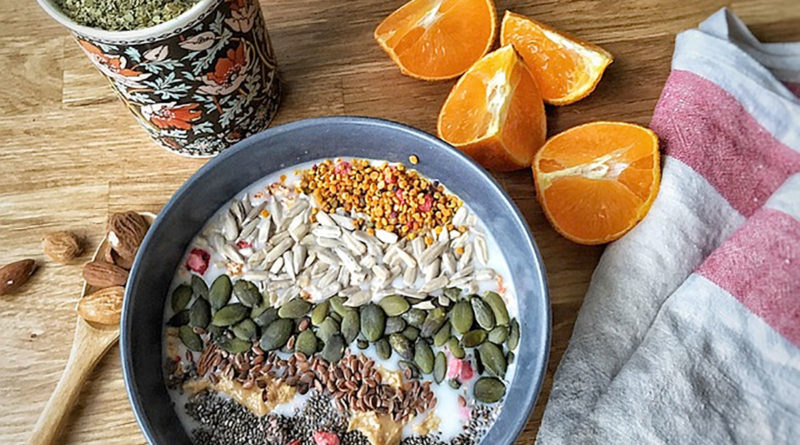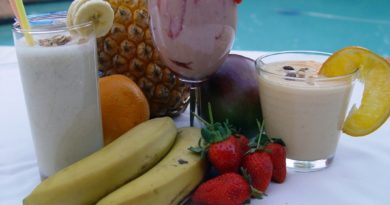Agni Teas
The basic human condition is dependent upon skillfully tending the fire within in the form of digestion. Life itself cannot be sustained if the process of learning how to tend this flame s is not of primary importance. This means that we are looking for ways our diet, lifestyle and relationships can support samagni or balanced digestion. Remember the children’s story of “Goldilocks and the Three Bears,” where she tests their porridge, chairs and beds to find the one that is just right? This is the essence of the science of Agni. We will know that our Agni is sama or balanced when what we eat makes us feel just right. Herbs and spices can have a pronounced and long term effect on the body and mind. That is why something as simple as an herbal tea when drank regularly can bring balance to the digestive fire.
Our ability to digest food is the keystone to good health and agni has four different forms it takes based on genetics, environment, consciousness. They are:
- Irregular digestion (Vishamagni)
- Slow digestion (Mandagni)
- Hot, intense digestion (Tikshnagni)
- Balanced, resilient digestion (Samagni)
As you can imagine we are all trying to bring the inner flame into a state of balance and equilibrium so that it responds accurately to any foods or experiences that we eat. If however, our body over or under responds, we can use Agni Teas to restore equilibrium and optimize the digestive and absorptive capacity of the digestive system.
A note about making teas
Formulating teas in Ayurvedic medicine follows a general pattern that allows for a synergy between the respective herbs that are utilized. This pattern has been described in many ways. The California College of Ayurveda describes a tea formulation as consisting of a 4 parts. These are:
- Chief – This is the primary herb that directs all the other herbs, like the CEO of the tea. It is in the highest proportion in the formula and thus has the strongest effect
- Support– This is the chief herbs primary support system and could be considered his/her direct reports or board of directors. They act in accordance with the CEO for an enhanced effect.
- Assist – The assist is like the administrative assistant, it has a smaller overall impact but without it the formula could not complete any task
- Carrier – This is the messenger or in our analogy it would be the phones, computers etc that are used to complete the task. Without it the energy of the previous parts would not go to the right place
Using this basic formula we can come up with a simple yet effective formulation for restoring our Agni back to samagni so that our food is efficiently utilized for maximum energy, vitality and health.
Vishama Agni tea blend
Get off the digestive roller coaster! If your agni has been taken over by the vata dosha you will experience irregular digestion characterized by gas, bloating or heaviness and gurgling in the abdomen. In addition to not overeating and instituting regular meal times, this tea blend can be helpful.
Chief: 1 teaspoon Fennel seed
Support: 1/2 teaspoon fresh ginger root
Assist: ½ teaspoon cinnamon stick pieces
Carrier: ¼ teaspoon licorice stick pieces
This sweet and spicy blend will help to normalize the reactivity of the digestive system. For the best results place all ingredients in 1 cup of water, bring to a boil, then strain into a cup and drink when warm. The chief herb is fennel, more information about its effects are below.
Fennel
Shatapushpa (Sankrit)
Foeniculum vulgaris; Umbelloferae
Character: The Soothing Spice
Fennel is a soothing digestive stimulant for variable digestion. Part of its effectiveness comes from its effect on the energetic system of the body known as the chakra’s and meridians. Fennel has been shown to be balancing to the lower three chakras and to balance the meridians associated with the kidney, liver, bladder, and spleen.
Guna: light, slightly oily
Rasa: sweet, pungent, bitter
Vipaka: sweet
Virya: cool
Prabhava: digestive aid
Main Action: Reduces gas, relieves muscle spasm, slightly diuretic
Action on Doshas: Balances all doshas
Action on Dhatus: Especially good for the blood, fat, and female reproductive tissues
Description:
Fennel not only improves digestion and absorption it also helps with cramping, muscle spasms, and gas. Because of its affect on the energetic body it has a grounding effect (Freeman, 2007) that helps the irregularity of digestion.
Main Uses:
- Spasm and pain of the abdomen (Choi, 2004)
- Improving enzymatic function to improve bloating, gas and indigestion (Singh et al, 2008)
- Malabsorption due to excess harmful bacteria (Lo-Cantore et al, 2004)
Special Uses: Fennel has traditionally been used to improve PMS symptoms and improve milk flow for nursing mothers.
Precautions: None
Manda Agni Tea Blend
Wake up from your hibernation! If your digestive strength is on vacation it is likely that kapha is blocking its natural flow. Although the appetite may appear strong on the surface only small meals can be taken without discomfort and heaviness in the abdomen, sleepiness after eating, nausea and fatigue. To remedy this sluggish digestion we use a tea with hot, stimulating spices.
Chief: 1 teaspoon fresh Ginger root cut into small pieces
Support: ½ teaspoon Tulsi leaves
Assist: ½ teaspoon Cloves
Carrier: ¼ teaspoon Stevia leaf
This spicy blend will wake up the digestive bear from hibernation. For the best results place cloves and ginger in a saucepan with 1 cup of water and bring to a boil, then turn off heat and add tulsi and stevia. In about 5 minutes strain the herbs and pour tea into a cup and drink when the tea has sufficiently cooled. The chief herb of the kapha tea is ginger and here is its monograph:
Ginger
Sunthi (Sanskrit)
Zingiber officianalis
Character: The Divine Digester
Ginger is the universal digester. Few things are as good at stimulating digestion as ginger. It has also shown benefit in arthritis by reducing cellular oxidation and inflammation similar to Turmeric.
Guna: Light, dry
Rasa: Pungent, Sweet
Vipaka: Pungent
Virya: Heating
Prabhava: Universal digester
Main Action: Digestive stimulant, carminative, antibacterial. anti-inflammatory and antioxidant.
Action on Doshas: Clears ama; balances kledaka Kapha. Increases Pitta and Vata
Action on Dhatus: Good for all dhatus
Description: Gingerol, gingerdiones, volatile oils and other bioactive constituents of ginger have a wide range of beneficial effects on the body (Koo, 2001). Although used in Ayurveda primarily as a digestive stimulant to combat the effects of ama (toxins) ginger has been shown to have anti-inflammatory and anti-oxidant properties useful in the treatment of cancer and arthritis. Although the fresh root is preferable the powder can also be used for health maintenance and healing.
Main Uses:
- Improves digestion and removes nausea. (Schmid et al 1994)
- Promotes proper metabolism of the pancreas and functioning of the liver. (Platel et al, 2000)
- Strengthens digestion and suppresses cancer. (Aggarwal et al 2008)
- As an anti-inflammatory for sprains, strains, and arthritis. (Kiuchi et al 1992)
Precautions:
- Caution in pregnancy
- High amounts in conjunction with antipsychotic drugs may increase absorption of MAO inhibitors and needs to be monitored by a physician. (Pole, pg 186)
Tikshna Agni Tea Blend
Cool your jets! When the bonfire of pitta mixes with the flame of agni it becomes more than the body can handle and will lead to dryness of the throat, acidity, and a feeling of burnout. There may a ravenous appetite that feels insatiable. In order to rejuvenate pitta and bring balance to the digestive fire cooling spices can be used.
Chief: 1 teaspoon Coriander seeds
Support: ½ teaspoon Cardamom seeds
Assist: ½ teaspoon Hibiscus powder
Carrier: ¼ teaspoon Turmeric powder or fresh root pieces
This cooling blend will cool the jets that are burning the inside of your body. For the best results place coriander seed and cardamom seed in a saucepan with a cup of water. Bring to a boil, turn off the heat and add hibiscus and turmeric. After 5 minutes strain herbs and pour into a cup. The main ingredient is coriander which will be explained below:
Coriander
Dhanyaka (Sanskrit)
Coriandrum sativum; Umbelliferae
Character: The burning body pacifier
Coriander is the seed of cilantro and it is very effective in balancing an overheated digestive system. As both the leaf of cilantro and the see it can be really helpful for reducing Pitta anywhere in the body.
Guna: Light, unctuous
Rasa: Astringent, bitter, sweet
Vipaka: Sweet
Virya: Warm
Prabhava: Can reduce swelling after trauma
Main Action: Cooling digestive stimulant. Relieves excess gas and bloating, diuretic.
Action on Doshas: Decreases all three doshas, aids pachaka pitta.
Action on Dhatus: Supports blood and smooth muscle tissue
Description: Coriander can be used safely to improve digestive capacity and absorption without aggravating acidity or inflammation. As is helps with excess heat in the abdomen it also improves symptoms of heat elsewhere in the body such as urinary tract infections, hot flashes and fever.
Main Uses:
- Digestive stimulant that removes toxicity (ama) and acts as an antioxidant.(Platel, et al, 2002)
- Improved absorption and digestion of fats (Chithra, et al, 1997)
- Mild diuretic. (Quaiser, et al, 2008)
- Relieves pain and swelling after trauma.(Tsai, et al, 2007)
Precautions: No drug-herb interactions known.
Watch the video on Youtube.
Conclusion
Balanced Agni is a key to health, and drinking these teas consistently for 1-2 weeks will have a noticeable effect on the digestive system. To do this it is helpful to pre-mix the herbs and store them in an airtight container, then simply use 2 teaspoons of tea blend for each cup that you brew. As you may identify with more than one of the types of Agni it can be helpful to work with an Ayurvedic professional. If you would like to work with Noah, please use the link below.
| References Aggarwal B. B, Kunnumakkara A. B, Harikumar K. B, Tharakan S. T, Sung B, Anand P. Potential of spice-derived phytochemicals for cancer prevention. Planta Med. 2008;74(13):1560–9. [PubMed] Chithra V, Leelamma S. Hypolipidemic effect of coriander seeds (Coriandrum sativum): mechanism of action. Plant Foods Hum Nutr. 1997;51(2):167-72. PubMed PMID: 9527351. Choi EM, Hwang JK. Antiinflammatory, analgesic and antioxidant activities of the fruit of Foeniculum vulgare. Fitoterapia. 2004;75:557–65. [PubMed] Freeman MP. Screening and treatment for women with mood disorders associated with reproductive events. J Clin Psychiatry. 2007;68(12):1946. [PubMed] Kiuchi F, Iwakami S, Shibuya M, Hanaoka F, Sankawa U. Inhibition of prostaglandin and leukotriene biosynthesis by gingerols and diarylheptanoids. Chem Pharm Bull (Tokyo). 1992;40(2):387–91. [PubMed] Koo K. L, Ammit A. J, Tran V. H, Duke C. C, Roufogalis B. D. Gingerols and related analogues inhibit arachidonic acid-induced human platelet serotonin release and aggregation. Thromb Res. 2001;103(5):387–97. [PubMed] Lo-Cantore P, Iacobellis NS, De-Marco A, Capasso F, Senatore F. Antibacterial activity of Coriander sativum L. and Foeniculum vulgare Miller Var. vulgare (Miller) essential oils. J Agri Food Chem. 2004;52:7862–7866. doi: 10.1021/jf0493122. [PubMed] [Cross Ref] Micklefield G. H, Redeker Y, Meister V, Jung O, Greving I, May B. Effects of ginger on gastroduodenalmotility. Int J Clin Pharmacol Ther. 1999;37(7):341–6. [PubMed] Platel K, Srinivasan K. Influence of dietary spices and their active principles on pancreatic diges-tiveenzymes in albino rats. Nahrung. 2000;44(1):42–6. [PubMed] Platel K, Rao A, Saraswathi G, Srinivasan K. Digestive stimulant action of three Indian spice mixes in experimental rats. Nahrung. 2002 Dec;46(6):394-8. PubMed PMID: 12577586. Qaiser Jabeen, Samra Bashir, Badiaa Lyoussi, Anwar H. Gilani, Coriander fruit exhibits gut modulatory, blood pressure lowering and diuretic activities, Journal of Ethnopharmacology, Volume 122, Issue 1, 25 February 2009, Pages 123-130, ISSN 0378-8741, http://dx.doi.org/10.1016/j.jep.2008.12.016. Schmid R, Schick T, Steffen R, Tschopp A, Wilk T. Comparison of seven commonly used agents for prophylaxis of seasickness. J Travel Med. 1994;1(4):203–6. Singh B, Kale RK. Chemomodulatory action of Foeniculum vulgare (Fennel) on skin and forestomach papillomagenesis, enzymes associated with xenobiotic metabolism and antioxidant status in murine model system. Food Chem Toxicol. 2008;46:3842–50. [PubMed] Tsai PJ, Tsai TH, Yu CH, Ho SC. Evaluation of NO-suppressing activity of several Mediterranean culinary spices. Food Chem Toxicol. 2007;45(3):440–7. [PubMed] |
Book a Session
-
 Ayurveda Session$250.00
Ayurveda Session$250.00




